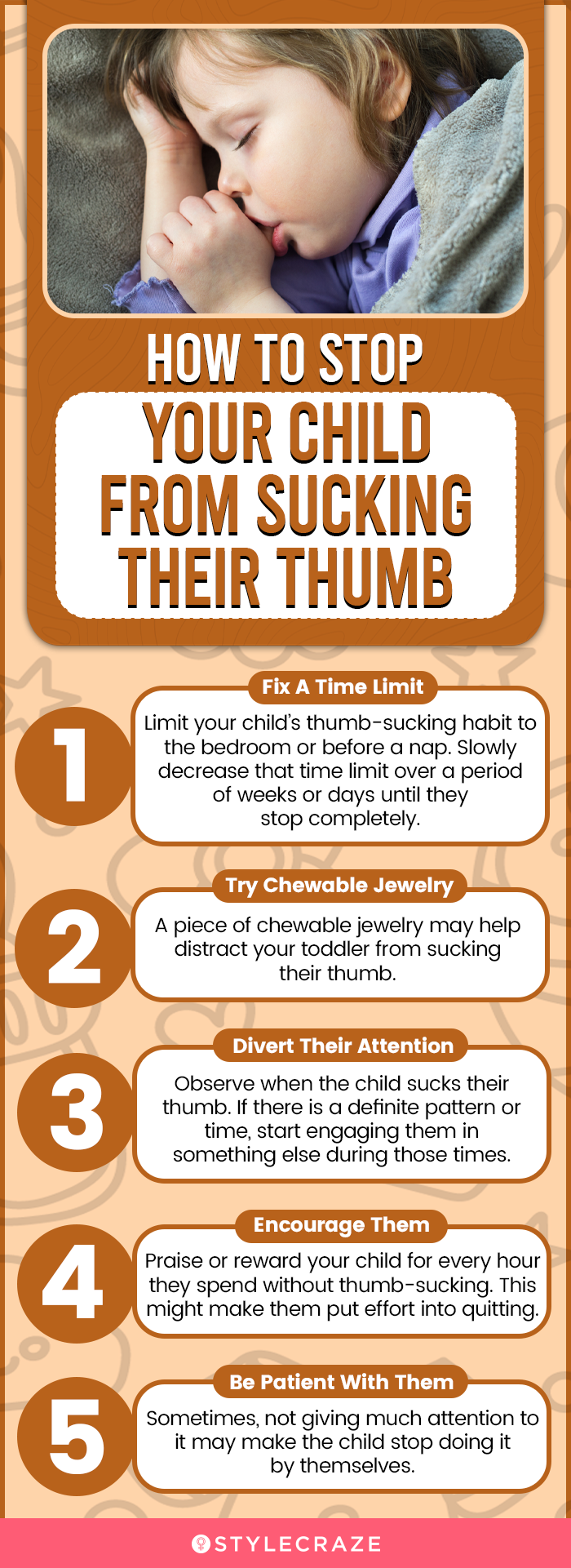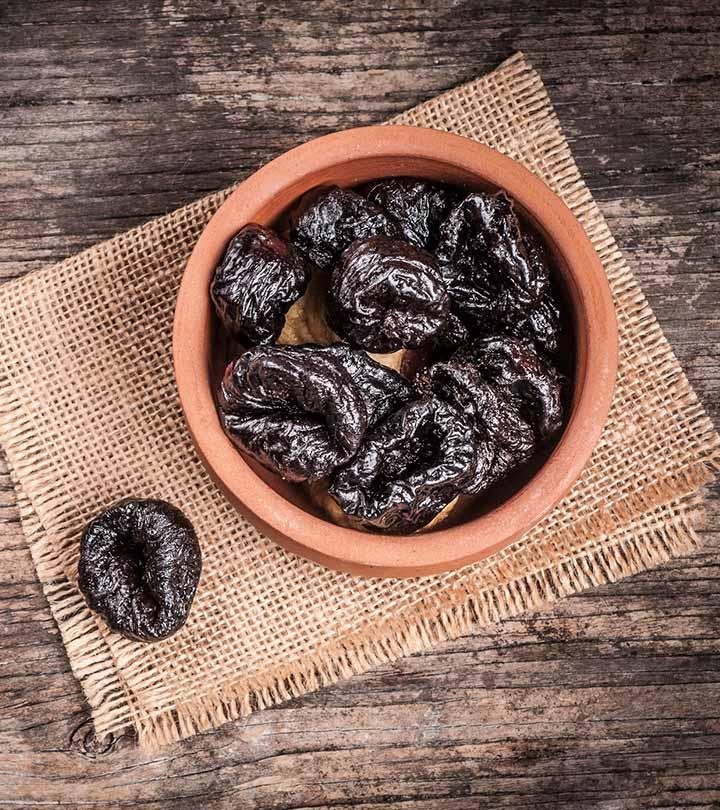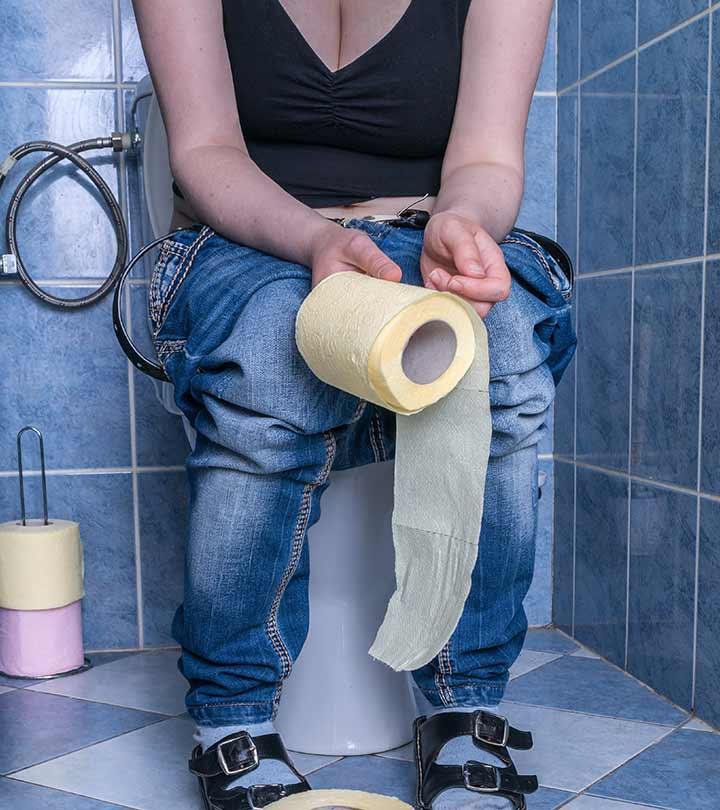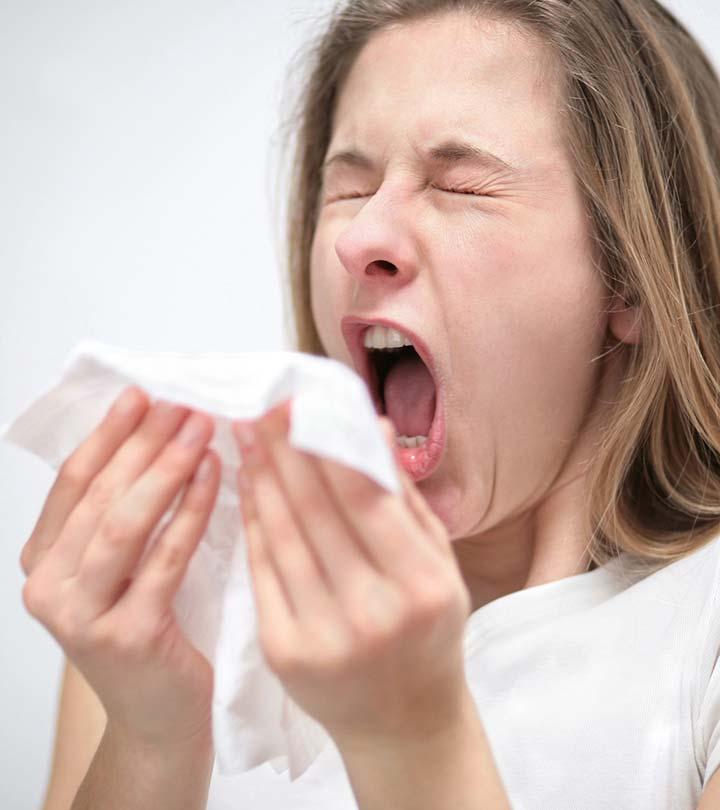8 Ways To Wean Your Baby Off Thumb Sucking
If it seems like an uphill climb, try some effective tips to help your toddler kick the habit.

Image: Shutterstock
Most children have a propensity to suck on their thumbs. This behavior usually begins in early childhood and may progress to the point where you must wean your baby off thumb sucking. Besides being a habit that is unhygienic, thumb sucking can have some adverse effects. For instance, sucking the thumb aggressively and repeatedly can raise your child’s chance of developing oral abnormalities. Continue reading to learn a few tips that may help your child quit sucking their thumb.
In This Article
Why Do Babies Suck Their Thumbs?
Babies usually suck their thumbs as they have natural rooting and sucking reflexes. These reflexes cause them to put their thumbs/fingers inside their mouths. Thumb sucking is also believed to make an infant feel safe and secure. Some babies develop this habit when they are in need of soothing, especially while going to sleep (1).
So, when do babies begin thumb sucking? Find out in the next section.
When Do Babies Start Sucking Their Thumbs?
Babies can start sucking their thumbs from as early as the 29th week of gestationi The period or process of development of a fetus inside the womb from the time of conception till birth. . This habit develops as they are born and may continue up to 2-3 years. However, most children stop doing this by the time they are 6 months old.
A study conducted on the US population showed that a 73% incidence of non-nutritive digit-sucking behavior was noted in children between 2 to 5 years. Also, digit or pacifier-sucking habit was found in 48% of children at 4 years of age, 12.1% in children older than 7 years, and 1.9% of 12-year-old children. It is very important to break this habit, so indulge in the following home remedies to help your children.
Thumb sucking is not a major issue in children. In fact, it is not of much concern until a child’s permanent teeth begin appearing. Once the permanent teeth begin to appear, it is best for your child to stop this habit to prevent damage to the teeth or problems with jaw alignment (2).
While you may want your child to stop thumb sucking, it may actually be beneficial for them. Find out in the next section.
Benefits Of Thumb Sucking
Thumb sucking may help your child in the following ways (3), (4):
- Babies and young children often suck their thumbs as a way to soothe and comfort themselves when they are upset or anxious.
- It may provide pain relief, particularly during teething when their gums may be sore and uncomfortable.
- It may strengthen their immune system as thumb sucking exposes them to everyday germs.
- Thumb sucking provides oral stimulation that may help in developing oral motor skills.
Nadine, a family counselor and blogger, talks about doing away with the negative connotation of thumb-sucking as it could be a sign that a child knows how to comfort themselves. She says how it has been a development for her son, and she trusts that he will grow up and learn to grab other objects to distract himself in other ways. “It just means that he is not crying in every situation he is not feeling happy in. This has made our day a lot more quiet and easier too, when he cries I usually know exactly what’s up because it must be something Mr. thumb can’t help with (i),” says Nadine, while highlighting how thumb-sucking has made monitoring a toddler convenient.
Most children tend to stop thumb sucking on their own. However, if this is carried too far, it may be time for the parent to intervene and help the child break this habit.
Listed below are some effective ways that can assist in stopping your child from sucking their thumb.
8 Best Ways To Stop Thumb Sucking In Babies
- Try And Limit The Time
- Warn About Germs
- Try Out Some Chewelry
- Observe When They Tend To Do It
- Praise Or Reward
- Avoid Using Finger Gloves/Covers
- Divert The Attention
- Be Patient And Wait A Wee Bit Longer
How To Stop Thumb Sucking In Babies
1. Try And Limit The Time
Start by limiting your child’s thumb sucking habit to the bedroom or before a nap. Try and explain to them that sucking the thumb is not to be done in public.
 Quick Tip
Quick Tip2. Warn About Germs
Warn your child about the germs on his/her hands and how sucking the thumb can cause infectious germs to spread and trigger diseases.The fear of ingesting harmful germs may pose an effective deterrent in helping some children give up the habit of thumb sucking.
3. Try Out Some Chewelry
Switching to chewelry, which is basically chewable jewelry, can help with the cessation of your toddler’s thumb sucking habit. It is an appealing substitute for them. You may find many options for this online.
4. Observe When They Tend To Do It
Children tend to suck their thumbs either during a nap or while watching television. Observe your child’s favorite thumb sucking time. If it is while watching television, go ahead and switch it off for a few minutes. You can also put a piece of chewelry in their mouth during bedtime to help your child stop thumb sucking.
 Quick Tip
Quick Tip5. Praise Or Reward
Praise or reward your toddler every time they do not have the thumb in the mouth. Give a sticker for every hour your child goes without sucking their thumb. This may provide encouragement and make them put more effort into quitting the habit.
6. Avoid Using Finger Gloves/Covers
Don’t put on a pair of gloves/covers on your toddler’s hands to make him/her quit the habit. This will only increase your child’s anxiety. And when they are old enough, they may just remove the gloves and suck their thumbs again. Instead, help them out of it slowly.
7. Divert Their Attention
Try to divert your baby’s attention every time you see him/her sucking the thumb. Give them a stress ball if you think they are sucking their thumb when they are nervous. If the toddler has been thumb sucking when bored, make them draw, paint, or play with toys as a distraction.
8. Be Patient
Remember, thumb sucking is a common habit in most kids. A majority of children give up sucking their thumb on their own with time. So, be a little patient and wait for them to stop it on their own.
While thumb sucking may seem soothing and calming to the baby in the initial stages, it also comes with its share of side effects. These side effects are usually quite gradual and occur in those children who suck their thumb vigorously and all too often.
What Are The Side Effects Of Thumb Sucking?
The side effects of thumb sucking are:
- Jaw deformities as the child enters adulthood
- Damage to the teeth alignment
- Teeth may be pushed around, resulting in an overbitei A dental misalignment in which the upper set of teeth protrude beyond the lower set of teeth. It is also called buck teeth. or underbitei A dental misalignment in which the lower teeth project beyond the upper set. It is also called teeth overcrowding.
- Formation of a lispi A type of speech impairment in which a person has trouble pronouncing sibilant sounds, such as “s,” “sh,” “z,” etc. due to problems with alignment of the jawbone
- Alteration of the roof of the mouth (palate)
- Bone deformities in the finger (5)
- Spreading of infectious germs
Infographic: How To Stop Your Child From Sucking Their Thumb
Many people find it difficult to stop babies from thumb-sucking. Though they will eventually stop this habit on their own, there are a few methods you can use to make them quit it quicker. Check out the infographic below for more information.

Illustration: StyleCraze Design Team
Thumb sucking in babies and children is quite common and is considered a manifestation of their natural rooting and sucking reflexes. Babies may begin sucking their thumbs for self-soothing and a sense of comfort soon after they are born. While most babies drop this habit by the time they reach six months, the child needs an intervention if the habit continues. The habit is not only unsightly and unhygienic but may also lead to oral structural deformities once the permanent teeth start showing up. Therefore, constant counseling or therapy is necessary once the child is old enough. Diversion techniques, patience, ‘chewellry’, praise and reward are some of the common practices to help children let go of a thumb sucking habit.
Frequently Asked Questions
Which is worse – the thumb or the pacifier?
Interestingly, both the thumb and the pacifier move a baby’s teeth similarly. Sucking on a thumb or a pacifier is not always harmful unless it develops into a habit. Even using finger guards can turn into a bad habit. You must ensure that the baby stops before they reach the age of three. Beyond that age, it can impact their dental development, resulting in crooked permanent teeth, a misaligned bite, and speech issues. However, remember that the pacifier can be removed, whereas the thumb cannot! As a result, pacifiers are preferable to thumb sucking.
Is thumb sucking hereditary?
No, thumb sucking is not hereditary. It is usually an indicator of a baby’s feelings of insecurity. Such babies need constant support from their parents who must try to wean the habit through gentle methods and perseverance.
Can thumb sucking recur or return after it has been successfully stopped, and what are some preventive measures?
No, thumb-sucking cannot recur or return after it has been successfully stopped. It usually ceases to happen after 2-4 years of age. A few preventive measures could be using chewers, guiding them about germs, or diverting their attention.
Can thumb sucking be replaced with another behavior or habit, such as a comfort object or fidget toy?
Yes, thumb sucking can be replaced with another behavior or habit, such as a comfort object or fidget toy as it would divert their attention and keep them engaged. Some calming activities such as playing with puzzles, or popping bubble wrap might also help.
Key Takeaways
- Thumb sucking can spread germs and damage your child’s teeth alignment.
- Provide your child with chewable jewelry to deviate from their thumb-sucking habit.
- Praise or reward your child every hour to make them stop thumb-sucking.
- Observe when they tend to suck their thumb. If they do it when they are scared, then try to engage them to make them safe.
- Jaw deformities and speech problems are common in children with thumb-sucking habits.
Is your baby hooked to thumb sucking? Click on this informative video to uncover the reasons behind it and get practical solutions to help break the habit gently and effectively.
Personal Experience: Source
StyleCraze's articles are interwoven with authentic personal narratives that provide depth and resonance to our content. Below are the sources of the personal accounts referenced in this article.
i. THUMBS UPhttps://piklerexperience.blogspot.com/2010/08/thumbs-up.html
References
Articles on StyleCraze are backed by verified information from peer-reviewed and academic research papers, reputed organizations, research institutions, and medical associations to ensure accuracy and relevance. Read our editorial policy to learn more.
- “Thumbsucking” American Academy of Pediatrics.
- “Effects of oral habits’ duration on dental characteristics in the primary dentition.” Journal of the American Dental Association, US National Library of Medicine.
- “Thumb sucking” U.S. National Library Of Medicine
- “The development of motor behavior” U.S. National Library Of Medicine
- “DYSTROPHIC CALCINOSIS IN A CHILD WITH A THUMB SUCKING HABIT: CASE REPORT” Semantic Scholar.
Read full bio of Dr. Jennifer Mercier
Read full bio of Arshiya Syeda
Read full bio of Moksha Gandhi






















